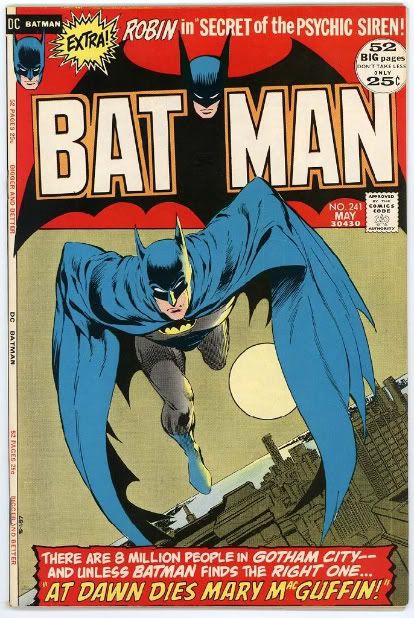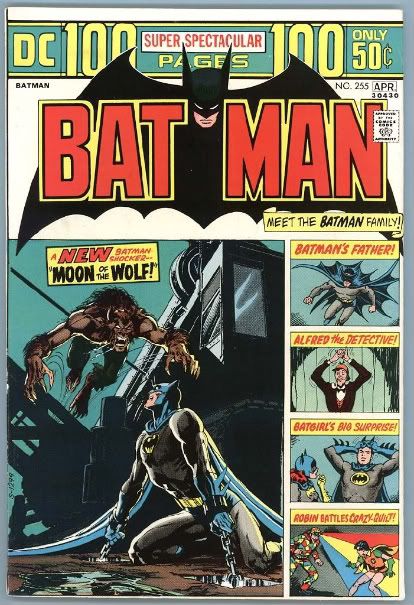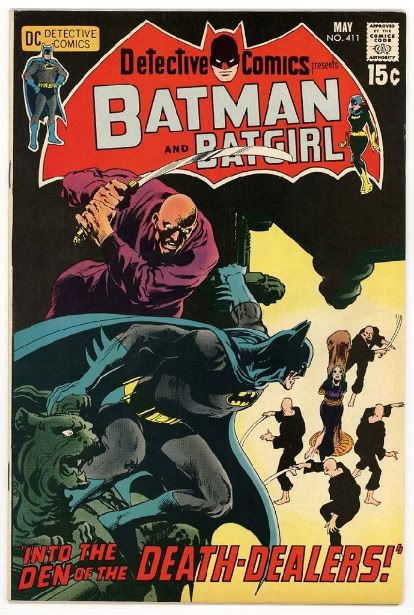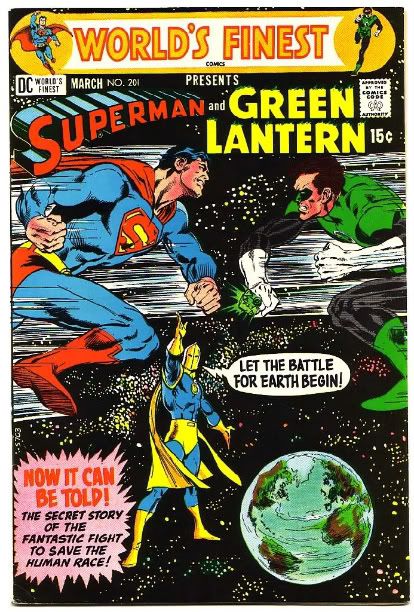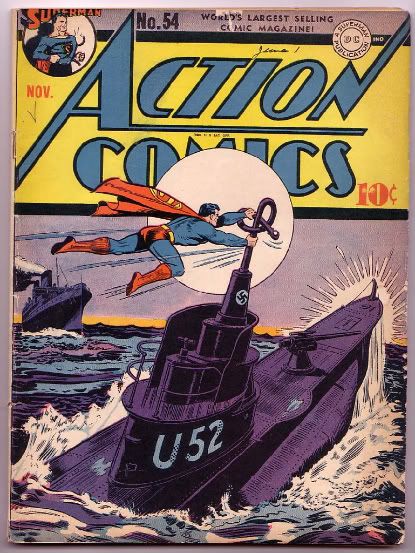Musings about autographs, comic books and other neat stuff.
Wednesday, December 30, 2009
More Neal Adams
Thanks to Blazing Bob for the Batmans and Detective Comics. Bob is not the least (or most) expensive dealer out there... but his grading is dead on, if not a bit conservative. I agreed with him on all of the books, except I think he slightly undergraded the Batman 241 at 8.5. I see no reason why it shouldn't be a 9.0.
From the Diamond Run collection:
I obtained the World's Finest from a CGC Forum member.
Saturday, December 19, 2009
Forgeries: Should buyers share the blame?
An interesting aspect of his videos is that he places 50% of the blame of the scourge of forgeries on the buyers who don't do their homework and buy obvious forgeries. He has a point.
Wednesday, December 16, 2009
Marvel's Greatest Comics For Only $1.00
From marvel.com
#######
Marvel is proud to announce the all-new MARVEL'S GREATEST COMICS imprint, spotlighting Marvel's most-acclaimed series with new printings of these must-read issues priced at only one dollar each! This bold new venture, launching in March 2010, offers a perfect jumping on point for new readers as well as provides retailers with a great low cost first chapter to some of the hottest selling Marvel Collected editions. And to really get things going, the first title from this line, INVINCIBLE IRON MAN #1, is free!
"We're proud of the books Marvel publishes and now not only are we giving retailers a great way to promote our top collections, but also giving consumers a chance to sample some of our top comics, maybe for the first time and at an unbeatable price," said David Gabriel, Marvel Senior Vice-President of Sales & Circulation. "MARVEL'S GREATEST COMICS represents one of the best values in comics today and with Free Comic Book Day only months after the initial launch, retailers will want to be well stocked."
The titles launching in March, at one per week, are:
March 3: INVINCIBLE IRON MAN #1
March 10: CAPTAIN AMERICA #1
March 17: WONDERFUL WIZARD OF OZ #1
March 24: THOR #1
March 31: PUNISHER MAX #1
Stay tuned for more details on MARVEL'S GREATEST COMICS at www.marvel.com!
Monday, December 14, 2009
Inside Edition investigates photos used to "authenticate" autographs
As always, caveat emptor!
Friday, December 11, 2009
Check out the Sports Locker
The Sports Locker focuses on sports cards and autographs. It's well written, interesting and well worth a visit.
Thursday, July 23, 2009
A Nancy Pelosi Story That Makes Me Smile
By Emily Heil and Elizabeth Brotherton
Roll Call Staff
July 22, 2009
Speaker Nancy Pelosi got dissed by astronaut Neil Armstrong after a ceremony at which the California Democrat honored the moonwalking hero and his historic Apollo 11 flight.
After the event marking the 40th anniversary of Armstrong's "giant leap for mankind," held in the Cannon House Office Building on Tuesday, an admiring Pelosi approached Armstrong with pen in hand, a witness to the snub tells HOH.
Pelosi asked the publicity-shy former astronaut to autograph something for her, but he wouldn't oblige. "I'm sorry, I don't do that anymore," Armstrong informed the autograph-seeker.
Turns out, Pelosi shouldn't take his put-down personally. Armstrong reportedly refuses all autograph requests, no matter how powerful the person asking. He stopped giving out his John Hancock years ago, news reports say, fearing forgeries and concerned about those making large amounts of money from autographed items.
In fact, Pelosi took getting turned down in stride, spokesman Brendan Daly says. "The Speaker would go to the moon and back to try to get what her grandson asked for," he tells HOH. "But he learned a valuable lesson: You can't always get what you want."
Wednesday, July 22, 2009
Salute to Apollo 11
 Even though Buzz Aldrin is a common signature, his signing fee is high (around $400 last time I checked). Apparently, he still gets people to pay the fee. A common signed Aldrin item might command $100 - $150 on ebay.
Even though Buzz Aldrin is a common signature, his signing fee is high (around $400 last time I checked). Apparently, he still gets people to pay the fee. A common signed Aldrin item might command $100 - $150 on ebay. Mike Collins used to be the most uncommon signature among the Apollo 11 crew. He signed freely for a few years after Apollo 11 until the mid-70s when he worked at the Smithsonian. After that, he became more reclusive; he didn't hide his dislike for autograph requests. In recent years, he has conducted private signings and appeared at a few signing events. Still, his signature is in high demand.
Mike Collins used to be the most uncommon signature among the Apollo 11 crew. He signed freely for a few years after Apollo 11 until the mid-70s when he worked at the Smithsonian. After that, he became more reclusive; he didn't hide his dislike for autograph requests. In recent years, he has conducted private signings and appeared at a few signing events. Still, his signature is in high demand. A signed Apollo 11 crew photo is one of the holy grails of astronaut autograph collecting, commanding thousands of dollars. While I'd love to have one in my collection, I think there is a higher probability of me being the next man to walk on the moon!
A signed Apollo 11 crew photo is one of the holy grails of astronaut autograph collecting, commanding thousands of dollars. While I'd love to have one in my collection, I think there is a higher probability of me being the next man to walk on the moon!
Wednesday, July 15, 2009
One giant signature for mankind

AMHERST, N.H. - Forty years ago on Thursday, astronaut Neil Armstrong hurtled into space aboard Apollo 11 for his rendezvous with immortality on the dusty surface of the moon.
But before he rode an elevator to the top of a 30-story-tall Saturn V rocket, Armstrong paused and wrote a check for $10.50 to a colleague.
“Here’s a check for the loan,’’ Armstrong said to Hal Collins, NASA chief of mission support. “But don’t cash it, because I will be coming back.’’
Four decades later, Armstrong’s autograph would become the most valuable from any living human being, collectors say. That check, with a clearly legible name that flows gracefully across its bottom, is now for sale through an auction house here.
“He’s the most sought-after human being for an autograph,’’ said Anthony Pizzitola of Houston, vice president of the Universal Autograph Collectors Club, the largest of its kind in the world. “That’s based on the fact that he just stopped signing in 1994. It’s just like a stock; that’s basically what it is.’’
The confluence of ultrarare qualities - an Armstrong signature, the timing of launch day, and the approaching anniversary - is sweet music to RR Auction, which is handling the sale here. Bids, which close at 10 p.m. tomorrow, appear likely to top the previous high of $19,000 for an Armstrong signing, Pizzitola said.
RR Auction owner Bob Eaton, whose modest storefront masks a star-studded office where Marilyn Monroe competes with Teddy Roosevelt for wall space, said the check shows something of Armstrong’s character. During a pressure-packed morning of flight preparations, the astronaut took time to repay a friend.
“Before he left for the moon, he wanted to show that this gentleman would be paid back,’’ said Eaton, a native of Newton, Mass., who first dipped his toes in the business at age 19, when he used an $1,800 loan from his grandfather to buy a heaping trove of baseball artifacts.
The check was offered for consignment by Noah Bradley of Charlottesville, Va., a collector of space memorabilia who bought the item from Collins’s son in 2002. With the anniversary of Armstrong’s moon walk approaching, Bradley decided to resell.
“As collectors, we are always temporary custodians of any item, and sometimes it’s time to let it go somewhere else,’’ said Bradley, 52, who restores and rebuilds historic homes. “If you’re interested in space collecting, Neil Armstrong is the pinnacle.’’
Armstrong’s is also a difficult autograph to acquire. The former test pilot and Korean War aviator, who became concerned about the profiteering and forgeries associated with his signature, stopped signing autographs for the public in 1994. He once even threatened to sue his longtime barber, who had sold a bit of Armstrong’s hair for $3,000.
What makes this autograph extra special, said Eaton, who recently sold a signed copy of the famous tongue-wagging photo of Albert Einstein, is that Armstrong included his rarely used middle initial. It was one of only three times he signed his full name, Neil A. Armstrong, during the Apollo 11 mission. The other two times were on a customs declaration after reentry and on a plaque left on the moon, according to the RR Auction staff.
Bids might top $30,000 by tomorrow’s deadline, predicted Bob Livingston, the auction’s director of sales and marketing. After the 10 p.m. window closes, bidders who participated before the deadline can submit new offers during 10-minute segments that are reset with each fresh bid. Once 10 minutes have passed without a new offer, the sale is closed.
Livingston predicted that bidding, primarily from baby boomers with keen memories of the July 20, 1969, moon landing, could continue until 6 a.m. Thursday. So far, bidding that opened July 10 has attracted interest from Europe and across the United States, the auction staff said.
The allure of an authenticated autograph, in addition to its monetary value, includes the knowledge that “it’s absolutely personal,’’ Livingston said.
RR Auction, which offers 1,500 items each month, handles the highest volume of autographs of any auction house in the country, Eaton said. The house’s fees for the Armstrong check will be 18 percent from the buyer and between 10 and 15 percent from the seller, Eaton said.
To walk through the business is to walk through a who’s who of signed photos and memorabilia from an array of politicians, sports figures, entertainers, and inventors.
Thomas Edison and the Wright brothers are favorites here, as well as luminaries as diverse as George Washington, Abraham Lincoln, P.T. Barnum, and Ted Williams.
There’s also a ticket to the US Senate gallery for the 1868 impeachment trial of President Andrew Johnson; a ticket to the 1935 trial of Bruno Hauptmann, executed in the kidnapping of Charles Lindbergh’s baby; and even a request from 1836, written in Spanish by Lieutenant Colonel William Travis, to buy beef for his doomed men at the Alamo.
From now through Wednesday, however, the focus will be on Armstrong, and a mission of unprecedented human exploration that captivated the world. What $10.50 had bought for a soon-to-be space traveler with no need for money - or any place to put spare cash and coins, for that matter - is unknown to Bradley or the auction house.
But what that check represented, in very human terms, is the unpredictable mortality of a mission whose sheer audacity seems magnified with every passing year.
“It captures that moment forever,’’ Livingston said.
Wednesday, July 08, 2009
More Does Not Always = Better
 Here's a sad example of not having enough sense to leave something alone. Why add a common $50 signature (Gene Cernan) to a rare and valuable item like an uninscribed Apollo 1 crew photo? This is like adding a Jimmy Carter signature to a document signed by Washington and Jefferson. Senseless and tasteless.
Here's a sad example of not having enough sense to leave something alone. Why add a common $50 signature (Gene Cernan) to a rare and valuable item like an uninscribed Apollo 1 crew photo? This is like adding a Jimmy Carter signature to a document signed by Washington and Jefferson. Senseless and tasteless.
Tuesday, July 07, 2009
Get Your Freeze-Dried Sod Here!
 For the fan that has almost everything -- a freeze dried 3 inch round clump of sod from the old Yankee Stadium. As stated in the ad, "*PLEASE NOTE, DIRT MAY FALL FROM BOTTOM OF SOD." Won't that make a nice display? A pile of dirt and freeze dried blades of grass jumbled up in a plastic cube like sod salad.
For the fan that has almost everything -- a freeze dried 3 inch round clump of sod from the old Yankee Stadium. As stated in the ad, "*PLEASE NOTE, DIRT MAY FALL FROM BOTTOM OF SOD." Won't that make a nice display? A pile of dirt and freeze dried blades of grass jumbled up in a plastic cube like sod salad.If money is no object, you can get a 20 x 20 foot piece of Authentic Yankee Stadium Sod from behind home plate with the interlocking NY... comes complete with a bag of peat moss, grass seed, and a flag stating its origin for only $50,000.
What will they think of selling next? Locker room used urinal cakes?
Wednesday, May 13, 2009
Essays and Articles on the Golden Age of Comic Books
 Noted comic book collector Jon Berk has granted the Network of Disclosure (NOD) the rights to reprint his wonderful essays and articles on the Golden Age of Comics.
Noted comic book collector Jon Berk has granted the Network of Disclosure (NOD) the rights to reprint his wonderful essays and articles on the Golden Age of Comics.Thursday, April 30, 2009
Action Comics 54 - The Nazi Sub
I'll start with this copy of Action Comics 54 I picked up earlier in 2009. I love the Action war covers, but they are getting harder and harder to acquire... seems like a lot of collectors have decided to focus on them. The competition now makes me wish I had worked a little harder at collecting them when I started years ago.
Thursday, April 23, 2009
I Am Mr. Zipper
But, maybe I found a better one.
I am now, MrZipper.com.
MrZipper.com will point to this blog for the foreseeable future. Now, maybe I'll have to change my message boards names to Mr. Zipper as well.
Zipper's Autograph Gallery
In any case, my original autograph collecting site, Zipper's Autograph Gallery is still online at the old Geocities address. I haven't updated it in quite some time, however it serves as a good resource and a bit of a time capsule. As long as Geocities will host it for free, I'll keep it there.
Wednesday, April 22, 2009
Bittersweet Thoughts of Days Gone By
I held onto the color funnies for a few years and eventually tossed them out because they were big and not easy to store. The guy from the local comic shop told me there was no demand for them and they were basically worthless... he didn't want them at any price. This was long before ebay, obviously...
I really wish I had kept them now. They'd probably be worth a few bucks, but more importantly, it would be a nice memento from my Grandmother's home. What I would give to be there just one more time... to sit at her kitchen table and butter a piece of bread while she stood at the stove cooking.
Visit The NOD Message Board
Lot's of great comics on display. You'll also see some of the hobby's most respected names hanging out. Oh, and Marnin Rosenberg is there too.
Where Fan Mail Goes to Get Answered
#######
Where Fan Mail Goes to Get Answered
By JOANNE KAUFMAN
In the course of her career as a psychotherapist, Shelley De Angelus counseled schizophrenics, patients with multiple personality disorder, and garden-variety neurotics.
Long exposure to people with inflated expectations, economy-size fantasies and delusions of grandeur serves her well in her current slot as the office manager of Mail Mann, Inc., a Los Angeles-based fan-mail and fan-club service. Daily, she or her colleague Marie Kehoe stops at the post office to pick up white plastic bins of letters addressed to such clients as Anna Paquin, Ralph Fiennes, Richard Gere, Reese Witherspoon, Kyra Sedgwick, Kevin Bacon, Joe Cocker and Samuel L. Jackson, as well as some cast members of the series "Two and a Half Men," "30 Rock" and "Brothers & Sisters."
They've got mail, thousands of missives a week -- from fans who want to express approval/disapproval of their idols' political stands, religious beliefs, recent headline-making behavior, taste in mates or taste in movie roles. From fans who want to express sympathy or support when there's been a death in the celeb's family. From straitened fans seeking cash (five- and six-figure requests are not uncommon) and from fans seeking a far more precious commodity: a date for the high-school prom.
"What surprises me is the intensity of the expectations," said Ms. De Angelus in a recent phone interview. "It's one thing when a 14-year-old writes 'take me to the prom.' But when a mother writes saying 'take my daughter to the prom,' you have to wonder."
She wonders equally about the woman who keeps those cards and letters coming for Chad Michael Murray, star of the series "One Tree Hill." "This fan seems to see him as her best friend," said Ms. De Angelus. "I find it astonishing seeing that she has written many times a week for years and has never gotten a response. Her letters are incredibly boring," she added.
The requests contained in such notes may vary, but the opening salvo and closing line are strikingly similar. "Everyone tends to start with 'I am your number one fan,'" Ms. De Angelus said. "And all the letters end with 'please send a picture."
Mail Mann is one of a small handful of companies that has taken over a job once handled solely by movie studios. "Years ago, that mail was seen as a very important gauge of an actor's popularity," said veteran publicist Lee Solters. "Now it's all about the box office: You're bankable or you're not bankable."
Named for its founder, Mackie Mann, a child actor who grew up to be a producer of TV commercials, Mail Mann was launched 25 years ago. "A friend who was a talent agent asked me if I knew anyone who did fan mail," recalled Ms. Mann. "She had a client, Peter Reckell, who's on 'Days of Our Lives.' At the time he was very big, a teen heartthrob, and I said I'd look into it. I started looking and I couldn't find anyone -- and I thought, hmmm."
She began Mail Mann in her garage, handling Mr. Reckell's correspondence, and soon signed up David Hasselhoff, then the star of the series "Knight Rider." Ms. Mann's husband, a dolly grip, was very helpful with client recruitment. "When he went on location, he would talk to stars about my business," she said. "I got a lot of people that way."
As time passed Ms. Mann increased her revenue stream by helping stars start fan clubs and by creating a Web site to sell celebrity merchandise.
There's an ebb and flow to the client roster. "We usually get called when celebrities all of a sudden have so much mail they don't know what to do with it," said Ms. Mann. "Then they stay with us while their career is peaking. But after a while their popularity may wind down and the expense of responding to their fans becomes more than they want to incur."
The decline in scripted programming has hurt the firm; an actor without a series or a movie of the week may not be getting a sufficient hillock of letters to need assistance in dealing with them.
There's a "set-up charge" of $250 and a minimum monthly charge of $125 for Mail Mann to pick up letters from the post office or a celebrity's home, retrieve emails and deal with correspondence per clients' wishes. For Emilio Estevez and Marina Sirtis, star of "Star Trek: The Next Generation," that means a form letter thanking fans for their support. For most others, it's the dispatch of a 5-by-7 photo (8-by-10s have gotten too expensive) with what's known in the trade as a plate signature (a mechanized copy of an autograph).
"We have a few customers like Hector Elizondo who will come in the office and sign their own photos," Ms. Kehoe said. "He's the sweetest guy in the world. I think Charlie Sheen also signs his photos. He likes to be liked by his fans."
Mail Mann screens letters for threatening content, with protocols in place for handling such situations. "We'll also keep a dubious letter on file for future reference if it's something we don't feel easy about but doesn't constitute an imminent threat," said Ms. De Angelus. The company is also on the lookout for letters that might be worthy of a celeb's special attention -- for example, a charity requesting a personalized item for a benefit auction or a fan with an especially compelling story. "I remember a letter from a young French girl whose father had never acknowledged her and she didn't have a lot of friends. She used Elijah Wood as a role model," said Ms. De Angelus, referring to the "Lord of the Rings" star. "He had inspired her to achieve quite a lot, so she got a personalized photo."
Another attention-getting letter came from a young gay man to the campy actress Elvira, saying that she was his fairy goth mother and had helped him through a difficult adolescence. He too received a personalized photo from his idol.
For some celebs less responsive than Elvira and Mr. Wood, "we're the last thing on the totem pole," said Ms. Mann. "They have managers, they have agents, they have publicists. They don't care about letters accumulating somewhere. The people who want their mail done understand that the fans make their careers."
